
A | B | C | D | E | F | G | H | CH | I | J | K | L | M | N | O | P | Q | R | S | T | U | V | W | X | Y | Z | 0 | 1 | 2 | 3 | 4 | 5 | 6 | 7 | 8 | 9
Kingdom of the Iranians | |
|---|---|
| 224–651 | |
Derafsh Kaviani
(royal standard) Simurgh
(imperial emblem) | |
 The Sasanian Empire at its greatest extent c. 620, under Khosrow II | |
| Capital | |
| Common languages | Middle Persian (official)[4] Other languages |
| Religion | |
| Government | Feudal monarchy[5] |
| Shahanshah | |
• 224–241 | Ardashir I (first) |
• 632–651 | Yazdegerd III (last) |
| Historical era | Late Antiquity |
| 28 April 224 | |
• The Iberian War | 526–532 |
| 602–628 | |
| 628–632 | |
| 633–651 | |
| 651 | |
| Area | |
| 550[7][8] | 3,500,000 km2 (1,400,000 sq mi) |
| History of Iran |
|---|
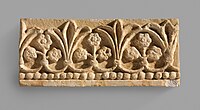 |
|
Timeline |
The Sasanian Empire (/səˈsɑːniən, səˈseɪniən/) or Sassanid Empire, sometimes referred to Second Persian Empire or Neo-Persian Empire[9], officially known as Eranshahr ("Kingdom of the Iranians"),[10][11] was the last Iranian empire before the early Muslim conquests of the 7th to 8th centuries. Named after the House of Sasan, it endured for over four centuries, from 224 to 651, making it the second longest-lived Persian imperial dynasty after the Arsacids of the Parthian Empire.[2][12]
The Sasanian Empire succeeded the Parthian Empire and re-established the Persians as a major power in late antiquity alongside its arch-rival, the Roman Empire (after 395 the Byzantine Empire).[13][14][15] The empire ended with the Muslim conquest of Persia. It was founded by Ardashir I, a ruler who rose to power as Parthia weakened as a result of internal strife and wars with the Romans. After defeating the last Parthian King of Kings, Artabanus IV, at the Battle of Hormozdgan in 224, he established the Sasanian Empire and set out to restore the legacy of the Achaemenid Empire by expanding Persia's dominions.
At its greatest territorial extent, the Sasanian Empire encompassed all of present-day Iran and Iraq, and stretched from the Levant to the Indian subcontinent and from South Arabia to the Caucasus and Central Asia.
The period of Sasanian rule was a high point in Iranian civilization,[16] characterized by a complex and centralized government bureaucracy, and revitalized Zoroastrianism as a legitimizing and unifying force of their rule.[17] They also built grand monuments, public works, and patronized cultural and educational institutions. The empire's cultural influence extended far beyond its territorial borders, including Western Europe,[18] Africa,[19] China, and India[20]—and helped shape European and Asian medieval art.[21]
Following the early Muslim conquests, the influence of Sasanian art, architecture, music, literature and philosophy on Islamic culture ensured the spread of Iranian culture, knowledge and ideas throughout the Muslim world.[22]
Name
Officially, the empire was known as the Kingdom of the Iranians (Middle Persian: ērānšahr, Parthian: aryānšahr, Greek: Arianōn ethnos); the term is first attested in the trilingual Great Inscription of Shapur I, where the king says "I am the lord of the Kingdom of the Iranians".[b][23]
More commonly, as the ruling dynasty was named after Sasan, the empire is known as the Sasanian Empire in historical and academic sources. This term is also recorded in English as the Sassanian Empire, the Sasanid Empire, and the Sassanid Empire. Historians have referred to the Sasanian Empire as the Neo-Persian Empire, since it was the second Iranian empire that rose from Pars (Persis),[9] while the Achaemenid Empire was the first.
History
Origins and early history (205–310)
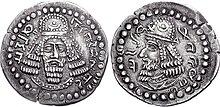
Obv: Bearded facing head, wearing diadem and Parthian-style tiara, legend "The divine Ardaxir, king" in Pahlavi.
Rev: Bearded head of Papak, wearing diadem and Parthian-style tiara, legend "son of the divinity Papak, king" in Pahlavi.
Conflicting accounts shroud the details of the fall of the Parthian Empire and subsequent rise of the Sassanian Empire in mystery.[24] The Sassanian Empire was established in Estakhr by Ardashir I.
Ardashir's father, Papak, was originally the ruler of a region called Khir. However, by 200, Papak had managed to overthrow Gochihr and appoint himself the new ruler of the Bazrangids. Papak's mother, Rodhagh, was the daughter of the provincial governor of Pars. Papak and his eldest son Shapur managed to expand their power over all of Pars. Subsequent events are unclear due to the elusive nature of the sources. It is certain that following the death of Papak, Ardashir, the governor of Darabgerd, became involved in a power struggle with his elder brother Shapur. Sources reveal that Shapur was killed when the roof of a building collapsed on him. By 208, over the protests of his other brothers, who were put to death, Ardashir declared himself ruler of Pars.[25][26]
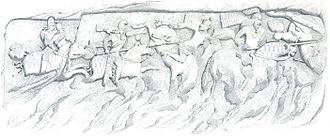
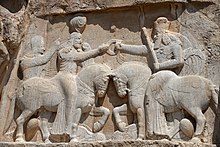
Once Ardashir was appointed shah (king), he moved his capital further to the south of Pars and founded Ardashir-Khwarrah (formerly Gur, modern day Firuzabad). The city, well protected by high mountains and easily defensible due to the narrow passes that approached it, became the center of Ardashir's efforts to gain more power. It was surrounded by a high, circular wall, probably copied from that of Darabgerd. Ardashir's palace was on the north side of the city; remains of it are extant. After establishing his rule over Pars, Ardashir rapidly extended his territory, demanding fealty from the local princes of Fars, and gaining control over the neighbouring provinces of Kerman, Isfahan, Susiana and Mesene. This expansion quickly came to the attention of Artabanus IV, the Parthian king, who initially ordered the governor of Khuzestan to wage war against Ardashir in 224, but Ardashir was victorious in the ensuing battles. In a second attempt to destroy Ardashir, Artabanus himself met Ardashir in battle at Hormozgan, where the former met his death. Following the death of the Parthian ruler, Ardashir went on to invade the western provinces of the now defunct Parthian Empire.[27]
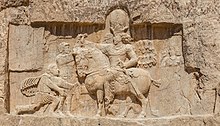
At that time the Arsacid dynasty was divided between supporters of Artabanus IV and Vologases VI, which probably allowed Ardashir to consolidate his authority in the south with little or no interference from the Parthians. Ardashir was aided by the geography of the province of Fars, which was separated from the rest of Iran.[28] Crowned in 224 at Ctesiphon as the sole ruler of Persia, Ardashir took the title shahanshah, or "King of Kings" (the inscriptions mention Adhur-Anahid as his Banbishnan banbishn, "Queen of Queens", but her relationship with Ardashir has not been fully established), bringing the 400-year-old Parthian Empire to an end, and beginning four centuries of Sassanid rule.[29]
In the next few years, local rebellions occurred throughout the empire. Nonetheless, Ardashir I further expanded his new empire to the east and northwest, conquering the provinces of Sakastan, Gorgan, Khorasan, Marw (in modern Turkmenistan), Balkh and Chorasmia. He also added Bahrain and Mosul to the Sassanid possessions. Later Sassanid inscriptions also claim the submission of the Kings of Kushan, Turan and Makuran to Ardashir, although based on numismatic evidence it is more likely that these actually submitted to Ardashir's son, the future Shapur I. In the west, assaults against Hatra, Armenia and Adiabene met with less success. In 230, Ardashir raided deep into Roman territory, and a Roman counter-offensive two years later ended inconclusively. Ardashīr began leading campaigns into Greater Khurasan as early as 233, extending his power to Khwarazm in the north and Sistan in the south while capturing lands from Gorgan to Abarshahr, Marw, and as far east as Balkh.[30]
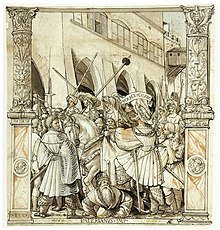
Ardashir I's son Shapur I continued the expansion of the empire, conquering Bactria and the western portion of the Kushan Empire, while leading several campaigns against Rome. Invading Roman Mesopotamia, Shapur I captured Carrhae and Nisibis, but in 243 the Roman general Timesitheus defeated the Persians at Rhesaina and regained the lost territories.[31] The emperor Gordian III's (238–244) subsequent advance down the Euphrates was defeated at Meshike (244), leading to Gordian's murder by his own troops and enabling Shapur to conclude a highly advantageous peace treaty with the new emperor Philip the Arab, by which he secured the immediate payment of 500,000 denarii and further annual payments.
Shapur soon resumed the war, defeated the Romans at Barbalissos (253), and then probably took and plundered Antioch.[31][32] Roman counter-attacks under the emperor Valerian ended in disaster when the Roman army was defeated and besieged at Edessa and Valerian was captured by Shapur, remaining his prisoner for the rest of his life. Shapur celebrated his victory by carving the impressive rock reliefs in Naqsh-e Rostam and Bishapur, as well as a monumental inscription in Persian and Greek in the vicinity of Persepolis. He exploited his success by advancing into Anatolia (260), but withdrew in disarray after defeats at the hands of the Romans and their Palmyrene ally Odaenathus, suffering the capture of his harem and the loss of all the Roman territories he had occupied.[33][34]

Shapur had intensive development plans. He ordered the construction of the first dam bridge in Iran and founded many cities, some settled in part by emigrants from the Roman territories, including Christians who could exercise their faith freely under Sassanid rule. Two cities, Bishapur and Nishapur, are named after him. He particularly favoured Manichaeism, protecting Mani (who dedicated one of his books, the Shabuhragan, to him) and sent many Manichaean missionaries abroad. He also befriended a Babylonian rabbi called Samuel.
This friendship was advantageous for the Jewish community and gave them a respite from the oppressive laws enacted against them. Later kings reversed Shapur's policy of religious tolerance. When Shapur's son Bahram I acceded to the throne, he was pressured by the Zoroastrian high-priest Kartir Bahram I to kill Mani and persecute his followers. Bahram II was also amenable to the wishes of the Zoroastrian priesthood.[36][37] During his reign, the Sassanid capital Ctesiphon was sacked by the Romans under Emperor Carus, and most of Armenia, after half a century of Persian rule, was ceded to Diocletian.[38]
Succeeding Bahram III (who ruled briefly in 293), Narseh embarked on another war with the Romans. After an early success against the Emperor Galerius near Callinicum on the Euphrates in 296, he was eventually decisively defeated by them. Galerius had been reinforced, probably in the spring of 298, by a new contingent collected from the empire's Danubian holdings.[39] Narseh did not advance from Armenia and Mesopotamia, leaving Galerius to lead the offensive in 298 with an attack on northern Mesopotamia via Armenia. Narseh retreated to Armenia to fight Galerius's force, to the former's disadvantage: the rugged Armenian terrain was favourable to Roman infantry, but not to Sassanid cavalry. Local aid gave Galerius the advantage of surprise over the Persian forces, and, in two successive battles, Galerius secured victories over Narseh.[40]

During the second encounter, Roman forces seized Narseh's camp, his treasury, his harem, and his wife.[40] Galerius advanced into Media and Adiabene, winning successive victories, most prominently near Erzurum, and securing Nisibis (Nusaybin, Turkey) before 1 October 298. He then advanced down the Tigris, taking Ctesiphon. Narseh had previously sent an ambassador to Galerius to plead for the return of his wives and children. Peace negotiations began in the spring of 299, with both Diocletian and Galerius presiding.
The conditions of the peace were heavy: Persia would give up territory to Rome, making the Tigris the boundary between the two empires. Further terms specified that Armenia was returned to Roman domination, with the fort of Ziatha as its border; Caucasian Iberia would pay allegiance to Rome under a Roman appointee; Nisibis, now under Roman rule, would become the sole conduit for trade between Persia and Rome; and Rome would exercise control over the five satrapies between the Tigris and Armenia: Ingilene, Sophanene (Sophene), Arzanene (Aghdznik), Corduene, and Zabdicene (near modern Hakkâri, Turkey).[41]
The Sassanids ceded five provinces west of the Tigris, and agreed not to interfere in the affairs of Armenia and Georgia.[42] In the aftermath of this defeat, Narseh gave up the throne and died a year later, leaving the Sassanid throne to his son, Hormizd II. Unrest spread throughout the land, and while the new king suppressed revolts in Sakastan and Kushan, he was unable to control the nobles and was subsequently killed by Bedouins on a hunting trip in 309.
First Golden Era (309–379)

Following Hormizd II's death, northern Arabs started to ravage and plunder the western cities of the empire, even attacking the province of Fars, the birthplace of the Sassanid kings. Meanwhile, Persian nobles killed Hormizd II's eldest son, blinded the second, and imprisoned the third (who later escaped into Roman territory). The throne was reserved for Shapur II, the unborn child of one of Hormizd II's wives who was crowned in utero: the crown was placed upon his mother's stomach.[43] During his youth the empire was controlled by his mother and the nobles. Upon coming of age, Shapur II assumed power and quickly proved to be an active and effective ruler.
He first led his small but disciplined army south against the Arabs, whom he defeated, securing the southern areas of the empire.[44] He then began his first campaign against the Romans in the west, where Persian forces won a series of battles but were unable to make territorial gains due to the failure of repeated sieges of the key frontier city of Nisibis, and Roman success in retaking the cities of Singara and Amida after they had previously fallen to the Persians.
These campaigns were halted by nomadic raids along the eastern borders of the empire, which threatened Transoxiana, a strategically critical area for control of the Silk Road. Shapur therefore marched east toward Transoxiana to meet the eastern nomads, leaving his local commanders to mount nuisance raids on the Romans.[45] He crushed the Central Asian tribes, and annexed the area as a new province.
In the east around 325, Shapur II regained the upper hand against the Kushano-Sasanian Kingdom and took control of large territories in areas now known as Afghanistan and Pakistan. Cultural expansion followed this victory, and Sasanian art penetrated Transoxiana, reaching as far as China. Shapur, along with the nomad King Grumbates, started his second campaign against the Romans in 359 and soon succeeded in retaking Singara and Amida. In response the Roman emperor Julian struck deep into Persian territory and defeated Shapur's forces at Ctesiphon. He failed to take the capital, however, and was killed while trying to retreat to Roman territory.[46] His successor Jovian, trapped on the east bank of the Tigris, had to hand over all the provinces the Persians had ceded to Rome in 298, as well as Nisibis and Singara, to secure safe passage for his army out of Persia.
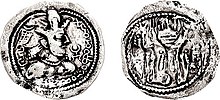
 and "Alchono" (αλχοννο) in Bactrian script on the obverse. Dated 400–440.[47]
and "Alchono" (αλχοννο) in Bactrian script on the obverse. Dated 400–440.[47]From around 370, however, towards the end of the reign of Shapur II, the Sasanians lost the control of Bactria to invaders from the north: first the Kidarites, then the Hephthalites and finally the Alchon Huns, who would follow up with an invasion of India.[48] These invaders initially issued coins based on Sasanian designs.[49] Various coins minted in Bactria and based on Sasanian designs are extant, often with busts imitating Sassanian kings Shapur II (r. 309 to 379) and Shapur III (r. 383 to 388), adding the Alchon Tamgha and the name "Alchono" in Bactrian script on the obverse, and with attendants to a fire altar on the reverse.[50]
Shapur II pursued a harsh religious policy. Under his reign, the collection of the Avesta, the sacred texts of Zoroastrianism, was completed, heresy and apostasy were punished, and Christians were persecuted. The latter was a reaction against the Christianization of the Roman Empire by Constantine the Great. Shapur II, like Shapur I, was amicable towards Jews, who lived in relative freedom and gained many advantages during his reign.[c] At the time of his death, the Persian Empire was stronger than ever, with its enemies to the east pacified and Armenia under Persian control.[46]
Intermediate Era (379–498)
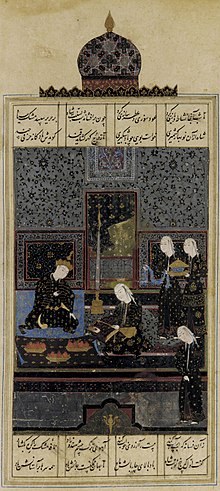
From Shapur II's death until Kavad I's first coronation, there was a largely peaceful period with the Romans (by this time the Eastern Roman or Byzantine Empire) engaged in just two brief wars with the Sassanian Empire, the first in 421–422 and the second in 440.[51][52][53][54] Throughout this era, Sasanian religious policy differed dramatically from king to king. Despite a series of weak leaders, the administrative system established during Shapur II's reign remained strong, and the empire continued to function effectively.[51]
After Shapur II died in 379, the empire passed on to his half-brother Ardashir II (379–383; son of Hormizd II) and his son Shapur III (383–388), neither of whom demonstrated their predecessor's skill in ruling. Bahram IV (388–399) also failed to achieve anything important for the empire. During this time Armenia was divided by a treaty between the Roman and Sasanian empires. The Sasanians reestablished their rule over Greater Armenia, while the Byzantine Empire held a small portion of western Armenia.
Bahram IV's son Yazdegerd I (399–421) is often compared to Constantine I. Both were physically and diplomatically powerful, opportunistic, practiced religious tolerance and provided freedom for the rise of religious minorities. Yazdegerd stopped the persecution against the Christians and punished nobles and priests who persecuted them. His reign marked a relatively peaceful era with the Romans, and he even took the young Theodosius II (408–450) under his guardianship. Yazdegerd also married a Jewish princess, who bore him a son called Narsi.
Yazdegerd I's successor was his son Bahram V (421–438), one of the most well-known Sasanian kings and the hero of many myths. These myths persisted even after the destruction of the Sasanian Empire by the Arabs. Bahram gained the crown after Yazdegerd's sudden death (or assassination), which occurred when the grandees opposed the king with the help of al-Mundhir, the Arabic dynast of al-Hirah. Bahram's mother was Shushandukht, the daughter of the Jewish Exilarch. In 427, he crushed an invasion in the east by the nomadic Hephthalites, extending his influence into Central Asia, where his portrait survived for centuries on the coinage of Bukhara (in modern Uzbekistan). Bahram deposed the vassal king of the Iranian-held area of Armenia and made it a province of the empire.
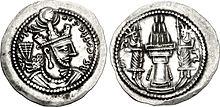
Bahram V's son Yazdegerd II (438–457) was in some ways a moderate ruler, but, in contrast to Yazdegerd I, he practised a harsh policy towards minority religions, particularly Christianity.[55] However, at the Battle of Avarayr in 451, the Armenian subjects led by Vardan Mamikonian reaffirmed Armenia's right to profess Christianity freely.[56][57] This was to be later confirmed by the Nvarsak Treaty (484).
At the beginning of his reign in 441, Yazdegerd II assembled an army of soldiers from various nations, including his Indian allies, and attacked the Byzantine Empire, but peace was soon restored after some small-scale fighting. He then gathered his forces in Nishapur in 443 and launched a prolonged campaign against the Kidarites. After a number of battles he crushed them and drove them out beyond the Oxus river in 450.[58] During his eastern campaign, Yazdegerd II grew suspicious of the Christians in the army and expelled them all from the governing body and army. He then persecuted the Christians in his land, and, to a much lesser extent, the Jews.[59] In order to reestablish Zoroastrianism in Armenia, he crushed an uprising of Armenian Christians at the Battle of Vartanantz in 451. The Armenians, however, remained primarily Christian. In his later years, he was engaged yet again with the Kidarites right up until his death in 457. Hormizd III (457–459), the younger son of Yazdegerd II, then ascended to the throne. During his short rule, he continually fought with his elder brother Peroz I, who had the support of the nobility,[59] and with the Hephthalites in Bactria. He was killed by his brother Peroz in 459.

At the beginning of the 5th century, the Hephthalites (White Huns), along with other nomadic groups, attacked Iran. At first Bahram V and Yazdegerd II inflicted decisive defeats against them and drove them back eastward. The Huns returned at the end of the 5th century and defeated Peroz I (457–484) in 483. Following this victory, the Huns invaded and plundered parts of eastern Iran continually for two years. They exacted heavy tribute for some years thereafter.
These attacks brought instability and chaos to the kingdom. Peroz tried again to drive out the Hephthalites, but on the way to Balkh his army was trapped by the Huns in the desert. Peroz was defeated and killed by a Hephthalite army near Balkh.[60][61] His army was completely destroyed, and his body was never found.[62] Four of his sons and brothers had also died.[63] The main Sasanian cities of the eastern region of Khorasan−Nishapur, Herat and Marw were now under Hephthalite rule.[61] Sukhra, a member of the Parthian House of Karen, one of the Seven Great Houses of Iran, quickly raised a new force and stopped the Hephthalites from achieving further success.[64] Peroz' brother, Balash, was elected as shah by the Iranian magnates, most notably Sukhra and the Mihranid general Shapur Mihran.[65]
Balash (484–488) was a mild and generous monarch, and showed care towards his subjects, including the Christians.[66] However, he proved unpopular among the nobility and clergy who had him deposed after just four years in 488.[66] Sukhra, who had played a key role in Balash's deposition,[66] appointed Peroz' son Kavad I as the new shah of Iran.[67] According to Miskawayh (d. 1030), Sukhra was Kavad's maternal uncle.[61] Kavad I (488–531) was an energetic and reformist ruler. He gave his support to the sect founded by Mazdak, son of Bamdad, who demanded that the rich should divide their wives and their wealth with the poor. By adopting the doctrine of the Mazdakites, his intention evidently was to break the influence of the magnates and the growing aristocracy. These reforms led to his being deposed and imprisoned in the Castle of Oblivion in Khuzestan, and his younger brother Jamasp (Zamaspes) became king in 496. Kavad, however, quickly escaped and was given refuge by the Hephthalite king.[68][69]
Jamasp (496–498) was installed on the Sasanian throne upon the deposition of Kavad I by members of the nobility. He was a good and kind king; he reduced taxes in order to improve the condition of the peasants and the poor. He was also an adherent of the mainstream Zoroastrian religion, diversions from which had cost Kavad I his throne and freedom. Jamasp's reign soon ended, however, when Kavad I, at the head of a large army granted to him by the Hephthalite king, returned to the empire's capital. Jamasp stepped down from his position and returned the throne to his brother.[70] No further mention of Jamasp is made after the restoration of Kavad I, but it is widely believed that he was treated favourably at the court of his brother.[71]
Second Golden Era (498–622)

The second golden era began after the second reign of Kavad I. With the support of the Hephthalites, Kavad launched a campaign against the Romans. In 502, he took Theodosiopolis in Armenia, but lost it soon afterwards. In 503 he took Amida on the Tigris. In 504, an invasion of Armenia by the western Huns from the Caucasus led to an armistice, the return of Amida to Roman control and a peace treaty in 506. In 521/522 Kavad lost control of Lazica, whose rulers switched their allegiance to the Romans; an attempt by the Iberians in 524/525 to do likewise triggered a war between Rome and Persia.
In 527, a Roman offensive against Nisibis was repulsed and Roman efforts to fortify positions near the frontier were thwarted. In 530, Kavad sent an army under Perozes to attack the important Roman frontier city of Dara. The army was met by the Roman general Belisarius, and, though superior in numbers, was defeated at the Battle of Dara. In the same year, a second Persian army under Mihr-Mihroe was defeated at Satala by Roman forces under Sittas and Dorotheus, but in 531 a Persian army accompanied by a Lakhmid contingent under Al-Mundhir III defeated Belisarius at the Battle of Callinicum, and in 532 an "eternal" peace was concluded.[72] Although he could not free himself from the Hephthalites, Kavad succeeded in restoring order in the interior and fought with general success against the Eastern Romans, founded several cities, some of which were named after him, and began to regulate taxation and internal administration.
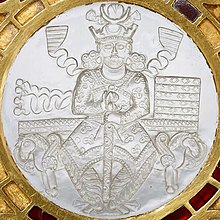
After the reign of Kavad I, his son Khosrow I, also known as Anushirvan ("with the immortal soul"; ruled 531–579), ascended to the throne. He is the most celebrated of the Sassanid rulers. Khosrow I is most famous for his reforms in the aging governing body of Sassanids. He introduced a rational system of taxation based upon a survey of landed possessions, which his father had begun, and he tried in every way to increase the welfare and the revenues of his empire. Previous great feudal lords fielded their own military equipment, followers, and retainers. Khosrow I developed a new force of dehqans, or "knights", paid and equipped by the central government[73] and the bureaucracy, tying the army and bureaucracy more closely to the central government than to local lords.[74]
Emperor Justinian I (527–565) paid Khosrow I 440,000 pieces of gold as a part of the "eternal peace" treaty of 532. In 540, Khosrow broke the treaty and invaded Syria, sacking Antioch and extorting large sums of money from a number of other cities. Further successes followed: in 541 Lazica defected to the Persian side, and in 542 a major Byzantine offensive in Armenia was defeated at Anglon. Also in 541, Khosrow I entered Lazica at the invitation of its king, captured the main Byzantine stronghold at Petra, and established another protectorate over the country,[75] commencing the Lazic War. A five-year truce agreed to in 545 was interrupted in 547 when Lazica again switched sides and eventually expelled its Persian garrison with Byzantine help; the war resumed but remained confined to Lazica, which was retained by the Byzantines when peace was concluded in 562.
In 565, Justinian I died and was succeeded by Justin II (565–578), who resolved to stop subsidies to Arab chieftains to restrain them from raiding Byzantine territory in Syria. A year earlier, the Sassanid governor of Armenia, Chihor-Vishnasp of the Suren family, built a fire temple at Dvin near modern Yerevan, and he put to death an influential member of the Mamikonian family, touching off a revolt which led to the massacre of the Persian governor and his guard in 571, while rebellion also broke out in Iberia. Justin II took advantage of the Armenian revolt to stop his yearly payments to Khosrow I for the defense of the Caucasus passes.
The Armenians were welcomed as allies, and an army was sent into Sassanid territory which besieged Nisibis in 573. However, dissension among the Byzantine generals not only led to an abandonment of the siege, but they in turn were besieged in the city of Dara, which was taken by the Persians. Capitalizing on this success, the Persians then ravaged Syria, causing Justin II to agree to make annual payments in exchange for a five-year truce on the Mesopotamian front, although the war continued elsewhere. In 576 Khosrow I led his last campaign, an offensive into Anatolia which sacked Sebasteia and Melitene, but ended in disaster: defeated outside Melitene, the Persians suffered heavy losses as they fled across the Euphrates under Byzantine attack. Taking advantage of Persian disarray, the Byzantines raided deep into Khosrow's territory, even mounting amphibious attacks across the Caspian Sea. Khosrow sued for peace, but he decided to continue the war after a victory by his general Tamkhosrow in Armenia in 577, and fighting resumed in Mesopotamia. The Armenian revolt came to an end with a general amnesty, which brought Armenia back into the Sassanid Empire.[73]
Around 570, "Ma 'd-Karib", half-brother of the King of Yemen, requested Khosrow I's intervention. Khosrow I sent a fleet and a small army under a commander called Vahriz to the area near present Aden, and they marched against the capital San'a'l, which was occupied. Saif, son of Mard-Karib, who had accompanied the expedition, became King sometime between 575 and 577. Thus, the Sassanids were able to establish a base in South Arabia to control the sea trade with the east. Later, the south Arabian kingdom renounced Sassanid overlordship, and another Persian expedition was sent in 598 that successfully annexed southern Arabia as a Sassanid province, which lasted until the time of troubles after Khosrow II.[73]
Khosrow I's reign witnessed the rise of the dihqans (literally, village lords), the petty landholding nobility who were the backbone of later Sassanid provincial administration and the tax collection system.[76] Khosrow I built infrastructure, embellishing his capital and founding new towns with the construction of new buildings. He rebuilt the canals and restocked the farms destroyed in the wars. He built strong fortifications at the passes and placed subject tribes in carefully chosen towns on the frontiers to act as guardians against invaders. He was tolerant of all religions, though he decreed that Zoroastrianism should be the official state religion, and was not unduly disturbed when one of his sons became a Christian.
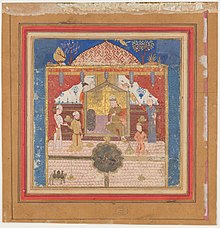
After Khosrow I, Hormizd IV (579–590) took the throne. The war with the Byzantines continued to rage intensely but inconclusively until the general Bahram Chobin, dismissed and humiliated by Hormizd, rose in revolt in 589. The following year, Hormizd was overthrown by a palace coup and his son Khosrow II (590–628) placed on the throne. However, this change of ruler failed to placate Bahram, who defeated Khosrow, forcing him to flee to Byzantine territory, and seized the throne for himself as Bahram VI. Khosrow asked the Byzantine Emperor Maurice (582–602) for assistance against Bahram, offering to cede the western Caucasus to the Byzantines. To cement the alliance, Khosrow also married Maurice's daughter Miriam. Under the command of Khosrow and the Byzantine generals Narses and John Mystacon, the new combined Byzantine-Persian army raised a rebellion against Bahram, defeating him at the Battle of Blarathon in 591. When Khosrow was subsequently restored to power he kept his promise, handing over control of western Armenia and Caucasian Iberia.

The new peace arrangement allowed the two empires to focus on military matters elsewhere: Khosrow focused on the Sassanid Empire's eastern frontier while Maurice restored Byzantine control of the Balkans. Circa 600, the Hephthalites had been raiding the Sassanid Empire as far as Spahan in central Iran. The Hephthalites issued numerous coins imitating the coinage of Khosrow II. In c. 606/607, Khosrow recalled Smbat IV Bagratuni from Persian Armenia and sent him to Iran to repel the Hephthalites. Smbat, with the aid of a Persian prince named Datoyean, repelled the Hephthalites from Persia, and plundered their domains in eastern Khorasan, where Smbat is said to have killed their king in single combat.[77]
After Maurice was overthrown and killed by Phocas (602–610) in 602, however, Khosrow II used the murder of his benefactor as a pretext to begin a new invasion, which benefited from continuing civil war in the Byzantine Empire and met little effective resistance. Khosrow's generals systematically subdued the heavily fortified frontier cities of Byzantine Mesopotamia and Armenia, laying the foundations for unprecedented expansion. The Persians overran Syria and captured Antioch in 611.
In 613, outside Antioch, the Persian generals Shahrbaraz and Shahin decisively defeated a major counter-attack led in person by the Byzantine emperor Heraclius. Thereafter, the Persian advance continued unchecked. Jerusalem fell in 614, Alexandria in 619, and the rest of Egypt by 621. The Sassanid dream of restoring the Achaemenid boundaries was almost complete, while the Byzantine Empire was on the verge of collapse. This remarkable peak of expansion was paralleled by a blossoming of Persian art, music, and architecture.
Decline and fall (622–651)
While successful at its first stage (from 602 to 622), the campaign of Khosrau II had actually exhausted the Persian army and treasuries. In an effort to rebuild the national treasuries, Khosrau overtaxed the population. Thus, while his empire was on the verge of total defeat, Heraclius (610–641) drew on all his diminished and devastated empire's remaining resources, reorganised his armies, and mounted a remarkable, risky counter-offensive. Between 622 and 627, he campaigned against the Persians in Anatolia and the Caucasus, winning a string of victories against Persian forces under Shahrbaraz, Shahin, and Shahraplakan (whose competition to claim the glory of personally defeating the Byzantine emperor contributed to their failure), sacking the great Zoroastrian temple at Ganzak, and securing assistance from the Khazars and Western Turkic Khaganate.

In response, Khosrau, in coordination with Avar and Slavic forces, launched a siege on the Byzantine capital of Constantinople in 626. The Sassanids, led by Shahrbaraz, attacked the city on the eastern side of the Bosphorus, while his Avar and Slavic allies invaded from the western side. Attempts to ferry the Persian forces across the Bosphorus to aid their allies (the Slavic forces being by far the most capable in siege warfare) were blocked by the Byzantine fleet, and the siege ended in failure. In 627–628, Heraclius mounted a winter invasion of Mesopotamia, and, despite the departure of his Khazar allies, defeated a Persian army commanded by Rhahzadh in the Battle of Nineveh. He then marched down the Tigris, devastating the country and sacking Khosrau's palace at Dastagerd. He was prevented from attacking Ctesiphon by the destruction of the bridges on the Nahrawan Canal and conducted further raids before withdrawing up the Diyala into north-western Iran.[78]
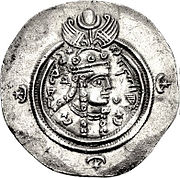
The impact of Heraclius's victories, the devastation of the richest territories of the Sassanid Empire, and the humiliating destruction of high-profile targets such as Ganzak and Dastagerd fatally undermined Khosrau's prestige and his support among the Persian aristocracy. In early 628, he was overthrown and murdered by his son Kavadh II (628), who immediately brought an end to the war, agreeing to withdraw from all occupied territories. In 629, Heraclius restored the True Cross to Jerusalem in a majestic ceremony.[78] Kavadh died within months, and chaos and civil war followed. Over a period of four years and five successive kings, the Sassanid Empire weakened considerably. The power of the central authority passed into the hands of the generals. It would take several years for a strong king to emerge from a series of coups, and the Sassanids never had time to recover fully.[76]
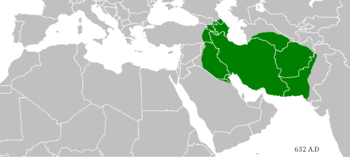
In early 632, a grandson of Khosrau I, who had lived in hiding in Estakhr, Yazdegerd III, acceded to the throne. The same year, the first raiders from the Arab tribes, newly united by Islam, arrived in Persian territory. According to Howard-Johnston, years of warfare had exhausted both the Byzantines and the Persians. The Sassanids were further weakened by economic decline, heavy taxation, religious unrest, rigid social stratification, the increasing power of the provincial landholders, and a rapid turnover of rulers, facilitating the Islamic conquest of Persia.[79]
The Sassanids never mounted a truly effective resistance to the pressure applied by the initial Arab armies. Yazdegerd was a boy at the mercy of his advisers and incapable of uniting a vast country crumbling into small feudal kingdoms, despite the fact that the Byzantines, under similar pressure from the newly expansive Arabs, were no longer a threat. Caliph Abu Bakr's commander Khalid ibn Walid, once one of Muhammad's chosen companions-in-arms and leader of the Arab army, moved to capture Iraq in a series of lightning battles. Redeployed to the Syrian front against the Byzantines in June 634, Khalid's successor in Iraq failed him, and the Muslims were defeated in the Battle of the Bridge in 634. However, the Arab threat did not stop there and reemerged shortly via the disciplined armies of Khalid ibn Walid.
Zdroj:https://en.wikipedia.org?pojem=Sassanid_PersiaText je dostupný za podmienok Creative Commons Attribution/Share-Alike License 3.0 Unported; prípadne za ďalších podmienok. Podrobnejšie informácie nájdete na stránke Podmienky použitia.
Antropológia
Aplikované vedy
Bibliometria
Dejiny vedy
Encyklopédie
Filozofia vedy
Forenzné vedy
Humanitné vedy
Knižničná veda
Kryogenika
Kryptológia
Kulturológia
Literárna veda
Medzidisciplinárne oblasti
Metódy kvantitatívnej analýzy
Metavedy
Metodika
Text je dostupný za podmienok Creative
Commons Attribution/Share-Alike License 3.0 Unported; prípadne za ďalších
podmienok.
Podrobnejšie informácie nájdete na stránke Podmienky
použitia.
www.astronomia.sk | www.biologia.sk | www.botanika.sk | www.dejiny.sk | www.economy.sk | www.elektrotechnika.sk | www.estetika.sk | www.farmakologia.sk | www.filozofia.sk | Fyzika | www.futurologia.sk | www.genetika.sk | www.chemia.sk | www.lingvistika.sk | www.politologia.sk | www.psychologia.sk | www.sexuologia.sk | www.sociologia.sk | www.veda.sk I www.zoologia.sk


